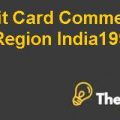Bluntly Media (Pvt.) Ltd. – A Private Company Valuation Case Study Solution
Introduction:
Bluntly Media is a private company. It is a marketing agency and started with a printing sector in 1990 but later evolved by adding digital printing services through the acquisition of a digital media company (Digital Media Solutions). The acquisition was a necessary change to cope up with the emerging demands of its clients.
The global crises of 2007 and 2008 in the world of finance tormented a lot of industries, but Media was not one of them. Although media clients, in the result of crises, decided to cut off their expenses, by finding a substitute for revenue booster. But media industry acted fast and came up with innovative digital media (mostly advertisement through social media).
This innovation resulted in the positive growth of media industry when most of the industries were down falling. Even after crises the Media industry kept on growing at a faster rate (of 7.1%) than overall US sales growth rate (of 5.1%)
Since its establishment in 1990, Bluntly Media has grown much larger, and currently is a group of three companies (Arrow Publishing, Bluntly Media and Digital Media Solutions). All three belongs to Media industry, but operates in different sectors i.e. “Arrow Publishing” provides printing, proofreading and sales and distribution services.“Bluntly Media”specializes in data analytics, catalogs and blow-ins and creative designs and “The Digital Media Solution” has expertise in digital video productions, website and graphic designing and other multimedia productions. This growth has attracted many acquirers and is probably the reason why a Fortune 200 company is considering to acquire it.
Issues of Valuation:
Value determination of any company can be done through different methods. There are various angles to look at the aspects of business, which gives the assessor the benefit of judgment. However, a business valuation can be very challenging at times, the process includes many hurdles, and the limitations exceed if the concerned business is a private company. Some of the significant limitations are highlighted as follows:
Forecast Assumptions:
The most common barrier in computing a business value are the limitations of assumptions. For instance, the weighted average cost of capital computed, is based on the assumption that it will remain the same for all upcoming years, which is doubtful. Furthermore, the projected cash-flows on which the discount factor is applied, are all based on historical data, and there is no precise method to support the idea that historical trend will keep up in future years.
Market analysis plays a crucial role in finding out the future stability, competitiveness and traditional flows of an industry. But this analysis cannot possibly account for sudden or accidental events. Hence the valuation based on this analysis are also not entirely reliable.
In addition to future assumptions, a valuer most likely uses comparable data, provided by rivals of the subject company and there is always a risk that the competitors are not presenting real view of their company, for obvious reasons.
Unavailability of a stable market:
A private company, regardless of its size, cannot be part of any Stock Exchange and the fact that no proper market is available to trade a private company also raises the concerns to its actual worth. Every listed company is bound to comply with regulations required by its stock exchange body, and in turn,their stock exchange body assesses their market value which is witnessed by the public. Private companies on the other side have no such body, which makes the valuation process more difficult. Unavailability of stock market frees private companies from many responsibilities
Weight age of Intangible Assets:
Intangible assets like goodwill, customer list, and different software are mostly valued on estimates. Specifically those Intangible assets, who does not have an open market for trade purpose. Even with compliance of IAS 38 (IntangibleAssets), It is impossible to keep a constant track on variations of these assets, and therefore difficult to assign an accurate value. It inherently puts a gap in standards and allows companies to manipulate their accounts as they find feasible.
For example, a customer list bought from the market may not have the same worth after a year. And if such list is not available for trade in the market (after a year), there will be no basis for the owner of that list to amortize the list, and so the company can choose to do nothing or amortize the list if need to. Thus the person responsible for valuation has to use whatever figure company presents....................
This is just a sample partial case solution. Please place the order on the website to order your own originally done case solution.













